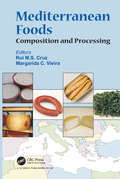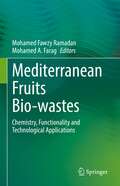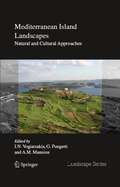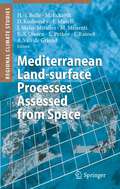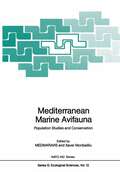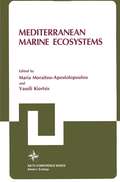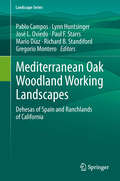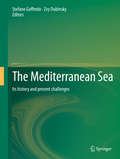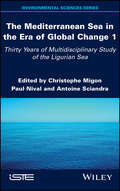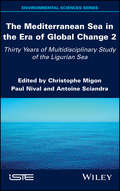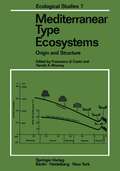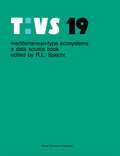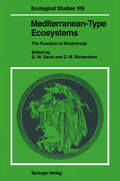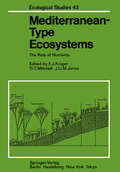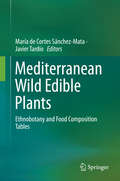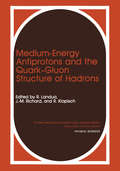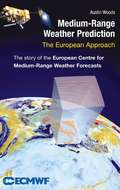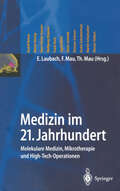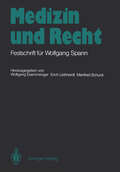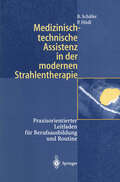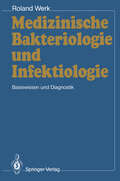- Table View
- List View
Mediterranean Foods: Composition and Processing
by Rui M. S. Da Cruz Maria M. C. VieiraThe Mediterranean region is well known around the world for its rich culinary history. While most books tend to only focus on the nutritional, culinary, and/or health aspects of Mediterranean cuisine, this book presents a more scientific approach and discusses the composition of specific foods from the Mediterranean basin as well as specific processing methodologies applied to produce food in this area of the world.
Mediterranean Foods: Composition and Processing
by Rui M.S. Cruz Margarida C. VieiraThe Mediterranean region is well known around the world for its rich culinary history. While most books tend to only focus on the nutritional, culinary, and/or health aspects of Mediterranean cuisine, this book presents a more scientific approach and discusses the composition of specific foods from the Mediterranean basin as well as specific processing methodologies applied to produce food in this area of the world.
Mediterranean Fruits Bio-wastes: Chemistry, Functionality and Technological Applications
by Mohamed Fawzy Ramadan Mohamed A. FaragTraditional Mediterranean fruits (i.e., be grapes, oranges, apples, pears, peaches, cherries, plums, figs, melons, watermelon and dates) are of major commercial and nutritional value to the region. Processing of such fruits, however, results in large amounts of bio-waste material. Efficient, inexpensive and environmentally friendly use of fruit industry waste is thus highly cost-effective and minimizes environmental impact. The natural antioxidants and bioactive compounds found in Mediterranean fruit bio-wastes could play a major role in the alleged health benefits of the Mediterranean diet, and could be used in pharmaceuticals as well as novel food applications. This book presents a multidisciplinary forum of discussion on the chemistry, functional properties and health-promoting effects of bioactive compounds in Mediterranean fruit bio-wastes, as well as novel food and non-food applications. The text provides the scientific fundamentals of the health-promoting benefits and applications of Mediterranean fruit bio-wastes, reviews the relevant recovery issues and explores different techniques to develop new applications. With a diversity of perspectives, from food science to environmental chemistry and horticultural research, this volume provides comprehensive, up-to-date knowledge to researchers and industry professionals working in the areas of food waste valorization.
Mediterranean Island Landscapes: Natural and Cultural Approaches (Landscape Series #9)
by A. M. Mannion Ioannis N. Vogiatzakis Gloria PungettiMediterranean islands exhibit many similarities in their biotic ecological, physical and environmental characteristics. There are also many differences in terms of their human colonization and current anthropogenic pressures. This book addresses in three sections these characteristics and examines the major environmental changes that the islands experienced during the Quaternary period. The first section provides details on natural and cultural factors which have shaped island landscapes. It describes the environmental and cultural changes of the Holocene and their effects on biota, as well as on the current human pressures that are now threats to the sustainability of the island communities. The second section focuses on the landscapes of the largest islands namely Sicily, Sardinia, Corsica, Cyprus, Crete, Malta and the Balearics. Each island chapter includes a special topic reflecting a particular characteristic of the island. Part three presents strategies for action towards sustainability in Mediterranean islands and concludes with a comparison between the largest islands. Despite several published books on Mediterranean ecosystems/landscapes there is no existing book dealing with Mediterranean islands in a collective manner. Students, researchers and university lecturers in environmental science, geography, biology and ecology will find this work invaluable as a cross-disciplinary text while planners and politicians will welcome the succinct summaries as background material to planning decisions.
Mediterranean Land-surface Processes Assessed from Space (Regional Climate Studies)
by Hans-Jürgen Bolle Matthias Eckardt Dirk Koslowsky Fabio Maselli Joaquin Melia Miralles Massimo Menenti Folke-Sören Olesen Ljiljana Petkov S. Ichtiaque Rasool Adriaan GriendThis is a detailed description of the steps leading from raw signals measured in space, to calibrated comparable long term data sets, to its final form: useful information for user communities. Examples of applications and data validations result from different investigations in the Mediteranean area. An appendix summarizes useful formulas of the evaluation of satellite data.
Mediterranean Marine Avifauna: Population Studies and Conservation (Nato ASI Subseries G: #12)
by Medmaravis Xaver MonbailliuMay I first congratulate, inconditionally, the Association MEDMARAVIS for organizing this symposium and for inviting me re presenting the Sardinian Ministry of the Environment. I would like to assert that such initiatives help a great deal and in a concrete way, Heads of government departments in charge of land use and natural resources. At this first symposium of the Mediterranean Marine Avifau na I must congratulate the scientific faculty for proposing such an ample spectrum of high quality papers dealing with diverse parts of the Mediterranean and beyond. I am sure that their con tributions will further scientific research, will help to pro tect our environment and will lead, more especially, to the ma nagement and conservation of seabirds. To know in order to manage has often been said at this sym posium. In fact, it is not possible to manage thoughtfully and rationally the natural resources without knowing more profound ly how they function. This reasoning is also valid on a more ge neral scale: regional planning of human activities should not disregard the evaluation of the ecosystem.
Mediterranean Marine Ecosystems (Nato Conference Series #8)
by Maria Moraitou-ApostolopoulouThis book contains the papers presented at a NATO Advanced Research Institute on "Mediterranean Marine Ecosystems", held at Heraklion-Crete, Greece, from September 23-27, 1983. A workshop rather than a conference, it was sponsored by the Eco-Sciences Special Programme Panel, in cooperation with the Marine Science Panel. The third of its kind, it was scheduled in the framework of a project on a multidisciplinary integrated approach to the study of the Mediterranean. This Sea and the surrounding land was not only the cradle of many civilizations but is, up to the present time, one of the major world areas of marine traffic, communication and exchanges, fisheries and aquacultures, inshore human activities and ••• pollu tion. To a certain degree it constitutes a gigantic natural labo ratory, where the fate of threatened aquatic and terrestrial eco systems including the human one, is tested. The Mediterranean Sea, with its geological history and present day geographic, hydrological and climatic conditions is believed to form an ecological entity. Important exchanges and mutual influences take place with the surrounding land area and the water masses, naturally (Atlantic, Black Sea) or artificially (Red Sea), connected to the Mediterranean. Therefore, a better and in-depth knowledge of the various ecosystems, benthic, planktonic and nektonic, neritic or pelagic, in the Western or the Eastern Basin seems to be a pre requisite to any action in preserving, upgrading and managing the natural resources of the area.
Mediterranean Oak Woodland Working Landscapes: Dehesas of Spain and Ranchlands of California (Landscape Series #16)
by Pablo Campos, Lynn Huntsinger, Jose Luis Oviedo Pro, Paul F Starrs, Mario Diaz, Richard B Standiford and Gregorio MonteroThe oak tree was a boon companion as humans expanded their presence across much of the globe. While oak woodlands (Quercus spp.) come today in stunningly diverse forms, the stately dehesas of Spain and the dramatic oak-dominated ranchlands of California are working landscapes where cultivation and manipulation for a couple of millennia have shaped Mediterranean-type ecosystems into a profoundly modified yet productive environment that is sought-after by every manner of species.The grazing of wildlife and livestock in oak woodlands yields a remarkable plant and animal biodiversity, creating a mosaic of habitats and visually pleasing savannas. Added products unique to Spain such as Iberian pigs and cork, and in California multiple landowner benefits, include valued ecosystem services that allow owners, visitors, and conservation supporters to experience the benefits of woodland life. With its 15 chapters a decade in the making, this handsomely illustrated book covers key topics in oak woodland policy, ecology, and management in Spain and California, presenting new research results and reviewing an existing expert literature.
The Mediterranean Sea: Its history and present challenges
by Stefano Goffredo Zvy DubinskyThis volume is an indispensable addition to the multidisciplinary coverage of the science of the Mediterranean Sea. The editors have gathered leading authorities from the fields of Marine Biology, Ecology, paleoclimatology, Chemical and Physical Oceanography, Zoology, Botany, Aquatic Photosynthesis, Socioeconomics, Mariculture, Mediterranean History and Science of Humanity. Beginning with the birth of the Mediterranean Sea and its myths. From coral to fish, an introduction is given to its major inhabitants of plants and animals past and present. The chapters illustrate how organisms interact as part of the structure and function of the Sea's main ecosystems. The rise of the Mediterranean as the cradle of the Western Civilization leads to a discourse on the status of human interaction with the sea. Accelerating global climate change, water warming, ocean acidification and sea level rise, and analyses of their effects on key organisms, entire ecosystems and human socioeconomics are given. Forecasting and predictions are presented taking into account different future scenarios from the IPCC (International Panel on Climate Change). The volume is richly illustrated in color, with an extensive bibliography. A valuable addition to the limited literature in the field, offering up-to-date broad coverage merging science and humanities.
The Mediterranean Sea in the Era of Global Change 1: 30 years of Multidisciplinary Study of the Ligurian Sea
by Christophe Migon Paul Nival Antoine SciandraDue to its particular characteristics, the Mediterranean Sea is often viewed as a microcosm of the World Ocean. Its proportionally-reduced dimensions and peculiar hydrological circulation render it susceptible to environmental and climatic constraints, which are rapidly evolving. The Mediterranean is therefore an ideal site to examine, in order to better understand a number of key oceanographic phenomena. This is especially true of the Ligurian Sea where, due to its geology, oceanic conditions are found close to the coast. As such, 30 years ago, an offshore time-series site provided a fresh impetus to a long history of marine biology research, which has generated a very important body of data and knowledge. This is the first volume, in a two-volume series, that summarizes this research. Across these two books, the reader will find 13 chapters that examine the geology, physics, chemistry and biology of the Ligurian Sea ? always with the goal of providing key elements of oceanography in a changing world.
The Mediterranean Sea in the Era of Global Change 1: 30 Years of Multidisciplinary Study of the Ligurian Sea
by Christophe Migon Paul Nival Antoine SciandraDue to its particular characteristics, the Mediterranean Sea is often viewed as a microcosm of the World Ocean. Its proportionally-reduced dimensions and peculiar hydrological circulation render it susceptible to environmental and climatic constraints, which are rapidly evolving. The Mediterranean is therefore an ideal site to examine, in order to better understand a number of key oceanographic phenomena. This is especially true of the Ligurian Sea where, due to its geology, oceanic conditions are found close to the coast. As such, 30 years ago, an offshore time-series site provided a fresh impetus to a long history of marine biology research, which has generated a very important body of data and knowledge. This is the first volume, in a two-volume series, that summarizes this research. Across these two books, the reader will find 13 chapters that examine the geology, physics, chemistry and biology of the Ligurian Sea ? always with the goal of providing key elements of oceanography in a changing world.
The Mediterranean Sea in the Era of Global Change 2: 30 Years of Multidisciplinary Study of the Ligurian Sea
by Christophe Migon Paul Nival Antoine SciandraDue to its particular characteristics, the Mediterranean Sea is often viewed as a microcosm of the World Ocean. Its proportionally-reduced dimensions and peculiar hydrological circulation render it susceptible to environmental and climatic constraints, which are rapidly evolving. The Mediterranean is therefore an ideal site to examine, in order to better understand a number of key oceanographic phenomena. This is especially true of the Ligurian Sea where, due to its geology, oceanic conditions are found close to the coast. As such, 30 years ago, an offshore time-series site provided a fresh impetus to a long history of marine biology research, which has generated a very important body of data and knowledge. This is the second volume, in a two-volume series, that summarizes this research. Across these two books, the reader will find 13 chapters that examine the geology, physics, chemistry and biology of the Ligurian Sea ? always with the goal of providing key elements of oceanography in a changing world.
The Mediterranean Sea in the Era of Global Change 2: 30 Years of Multidisciplinary Study of the Ligurian Sea
by Christophe Migon Paul Nival Antoine SciandraDue to its particular characteristics, the Mediterranean Sea is often viewed as a microcosm of the World Ocean. Its proportionally-reduced dimensions and peculiar hydrological circulation render it susceptible to environmental and climatic constraints, which are rapidly evolving. The Mediterranean is therefore an ideal site to examine, in order to better understand a number of key oceanographic phenomena. This is especially true of the Ligurian Sea where, due to its geology, oceanic conditions are found close to the coast. As such, 30 years ago, an offshore time-series site provided a fresh impetus to a long history of marine biology research, which has generated a very important body of data and knowledge. This is the second volume, in a two-volume series, that summarizes this research. Across these two books, the reader will find 13 chapters that examine the geology, physics, chemistry and biology of the Ligurian Sea ? always with the goal of providing key elements of oceanography in a changing world.
Mediterranean Type Ecosystems: Origin and Structure (Ecological Studies #7)
by Francesco Di Castri Harold A. MooneyNo other disjunct pieces of land present such striking similarities as the widely sepa 1 rated regions with a mediterranean type of climate, that is, the territories fringing the Mediterranean Sea, California, Central Chile and the southernmost strips of South Mrica and Australia. Similarities are not confined to climatic trends, but are also reflected in the physiognomy ofthe vegetation, in land use patterns and frequently in the general appearance of the landscape. The very close similarities in agricultural practices and sometimes also in rural settlements are dependent on the climatic and edaphic analogies, as well as on a certain commonality in qdtural history. This is certainly true for the Mediterranean Sea basin which in many ways represents a sort of ecological-cultural unit; this is also valid for CaUfornia and Chile, which were both settled by Spaniards and which showed periods of vigorous commercial and cultural interchanges as during the California gold rush. One other general feature is the massive interchange of cultivated and weed species of plants that has occurred between the five areas of the world that have a mediterranean-type climate, with the Mediterranean basin region itself as a major source. In spite of their limited territorial extension, probably no other parts of the world have played a more fundamental role in the history of mankind. Phoenician, Etruscan, Hellenic, Jewish, Roman, Christian andArab civilizations, among others,haveshapedmanyofman's present attitudes, including his position and perception vis-a-vis nature.
Mediterranean-type Ecosystems: A data source book (Tasks for Vegetation Science #19)
by P. C. Catling J. D. Majer P. Greenslade R. L. Specht P. W. Rundel W. E. WestmanThe regions of the world which experience a mediterranean type climate, with a cool wet season alternating with a hot dry summer, contain some of the world's most attractive landscapes. In the Old World, the mediterranean landscapes became the cradle of civilization; other mediterranean areas of the world have attracted considerable populations for many centuries. These large human populations have exerted consid erable stress on the fragile ecosystems which developed in these sunny, but droughted, fire-prone land scapes. The mediterranean landscape has thus become one of the most threatened in the world. In recent years much has been learned about the structure and function of mediterranean-type ecosystems (Di Castri and Mooney 1973, Mooney 1977, Thrower and Bradbury 1977, Mooney and Conrad 1977, Specht 1979, 1981, Miller 1981, Di Castri et at. 1981, Conrad and Oeche11982, Queze11982, Margaris and Mooney 1981, Kruger et ai. 1983, Long and Pons 1984, Dell et ai. 1986, Tenhunen et ai. 1987). Much of this research has been fostered under the International Biological Program (IBP), UNESCO Man and the Biosphere Program (MAB) and, recently, the International Society of Mediterranean Ecologists (ISOMED). To facilitate intercontinental comparisons, many of these studies have concentrated on a limited number of intensive sites thought to be representative of a general region.
Mediterranean-Type Ecosystems: The Function of Biodiversity (Ecological Studies #109)
by George W. Davis David M. RichardsonHuman activities are causing species extinctions at a rate and magnitude rivaling those of past geologic extinction events. Exploring mediterranean-type ecosystems - the Mediterranean Basin, California, Chile, Australia, and South Africa - this volume addresses the question whether biological diversity plays a significant role in the functioning of natural ecosystems, and to what extent that diversity can be reduced without causing system malfunction. Comparative studies in ecosystems that are similar in certain respects, but differ in others, offer considerable scope for gaining new insights into the links between biodiversity and ecosystem functioning.
Mediterranean-Type Ecosystems: The Role of Nutrients (Ecological Studies #43)
by F. J. Kruger D. T. Mitchell J. U. M. JarvisThe theory of ecological convergence underlies the biogeographers' maps of world biome-types. It also determines the degree to which ecological principles, derived from research on particular populations, communities or ecosystems, are generally valid, and hence also to what extent resource management principles are general. To quote Di Castri and Mooney (1973): "In effect, in order to assess the transfer of technology, it is essential to know to what extent information acquired from studying one particular ecosystem is applicable to another ecosystem of the same type but situated in a different location. " The five relatively small, isolated, mediterranean-climate zones of the earth, each with its distinct fauna and flora, have provided the ideal testing grounds for this theory. A heritage of precisely focused ecosystems research has resulted, beginning with the international comparative analyses conducted by Specht (l969a, b) but with antecedents in earlier studies in South Australia (Specht and Rayson 1957, Specht 1973). Cody and Mooney (1978) reviewed the information available at the time for the four zones excepting Australia and concluded that the arrays of strategy-types to be found among the different biotas were so similar that they could be explained only in terms of the convergence hypothesis; nevertheless, evident differences in community organization and dynamics, especially phenol ogy, required closer study of resource availability and resource-use patterns to better explain relations between form and function overall, and to assess the degree of convergence at higher levels of organization than the population.
Mediterranean Wild Edible Plants: Ethnobotany and Food Composition Tables
by María de Cortes Sánchez-Mata Javier TardíoThis book is the result of collaboration between botanists and food chemists, with the purpose of improving the knowledge of the main wild species of traditional use as foods in the Mediterranean area, focus on ethnobotanical aspects, natural production, uses and nutritional aspects. One of the novelties of the book would be the publication of complete food composition tables of more than 40 species, which are not usually included in nutrient databases of foods. Many of the data included comes from the chemical analysis of representative samples of these species and other are compiled from the scientific literature. Since this topic had not been fully studied, this book provides an interesting tool to be used with the purpose of the revalorization of wild food species, preservation of their traditional uses, and also as alternatives to improve the diversity of modern Mediterranean diets.
Medium-Energy Antiprotons and the Quark—Gluon Structure of Hadrons (Ettore Majorana International Science Series #58)
by R. Klapisch R. Landua J. M. RichardThe fourth course of the International School on Physics with Low Energy Antiprotons was held in Erice, Sicily, at the Ettore Majorana Centre for Scientific Culture from 25 to 31 January, 1990. The previous courses covered topics related to fundamental symmetries, light and heavy quark spectroscopy, and antiproton-nucleus interactions. The purpose of this school is to review theoretical and experimental aspects of low energy antiproton physics concerning the quark-gluon structure of hadrons and the dynamics of the. antiproton-nucleon interaction. Another important objective is the discussion of future directions of research with low-and medium-energy antiprotons in the context of future medium energy facilities at CERN and elsewhere. These proceedings contain both the tutorial lectures and the various contributions presented during the school by the participants. The proceedings have been organised in three sections. The first section is devoted to the theoretical lectures and contributions. The selection of the various subjects wants to emphasize the correlation between antiproton-nucleon physics and the underlying description in terms of quarks and gluons. The second section contains an overview about 35 years of experiments with antiprotons. It gives an introduction to the particle physics aspects of the field by outlining the historical development of experiment and theory, and by describing the motivation and the results of three recent LEAR experiments in more detail. The third section contains most of the contributions of the participants describing in more detail certain aspects of current or planned experiments at LEAR.
Medium-Range Weather Prediction: The European Approach
by Austin WoodsThis book provides an overview of the early years of the European Centre for Medium-Range Weather Forecasts, and reviews the work of the institute over the past 30 years, describing along the way the European approach to medium-range weather forecasting. Its combination of historical view and scientific insight is unique.
Medizin im 21. Jahrhundert: Molekulare Medizin, Mikrotherapie und High-Tech-Operationen
by E. Laubach T. MauFaszinierende Einblicke in die Medizin im 21. Jahrhundert: - Modernste molekulargenetische Verfahren zur Diagnostik und Therapie bisher unheilbarer Erkrankungen wie z.B. Alzheimer - Minimal invasive Techniken in der Neuroradiologie, Wirbelsäulenchirurgie, operativen Urologie, Kardiologie und Ophthalmologie - Navigation und Robotik in der Neurochirurgie, Orthopädie und Traumatologie Kompakt, verständlich und praxisnah: Eine Informationsquelle, die Ihren Wissensvorsprung sichert.
Medizin und Recht: Festschrift für Wolfgang Spann
by Wolfgang Eisenmenger Erich Liebhardt Manfred SchuckMedizinisch-technische Assistenz in der modernen Strahlentherapie: Praxisorientierter Leitfaden für Berufsausbildung und Routine
by Birgit Schäfer Peter HödlLeichter Einstieg in die Praxis f? MTARs und Berufsanf?ger. Mit anschaulichen Beispielen f? Theorie und Anwendung.
Medizinische Akutversorgung nach sexualisierter Gewalt: Ein forensisch-klinischer Praxisleitfaden
by Corinna A. Schön Katja WolfBei der Akutversorgung von Personen, die sexualisierte Gewalt erlebt haben, gilt es für erstversorgende Ärzte, einiges zu beachten und zu bedenken. Dieses Buch informiert darüber, welche Untersuchungen unabdingbar sind, wie Verletzungen gerichtsverwertbar dokumentiert und wie Spuren korrekt gesichert werden. Weiterhin finden sich Informationen zu möglichen Infektionsrisiken, zu K.O.-Mitteln, zur anschließenden Betreuung sowie zu rechtlichen Fragestellungen in diesem Zusammenhang.
